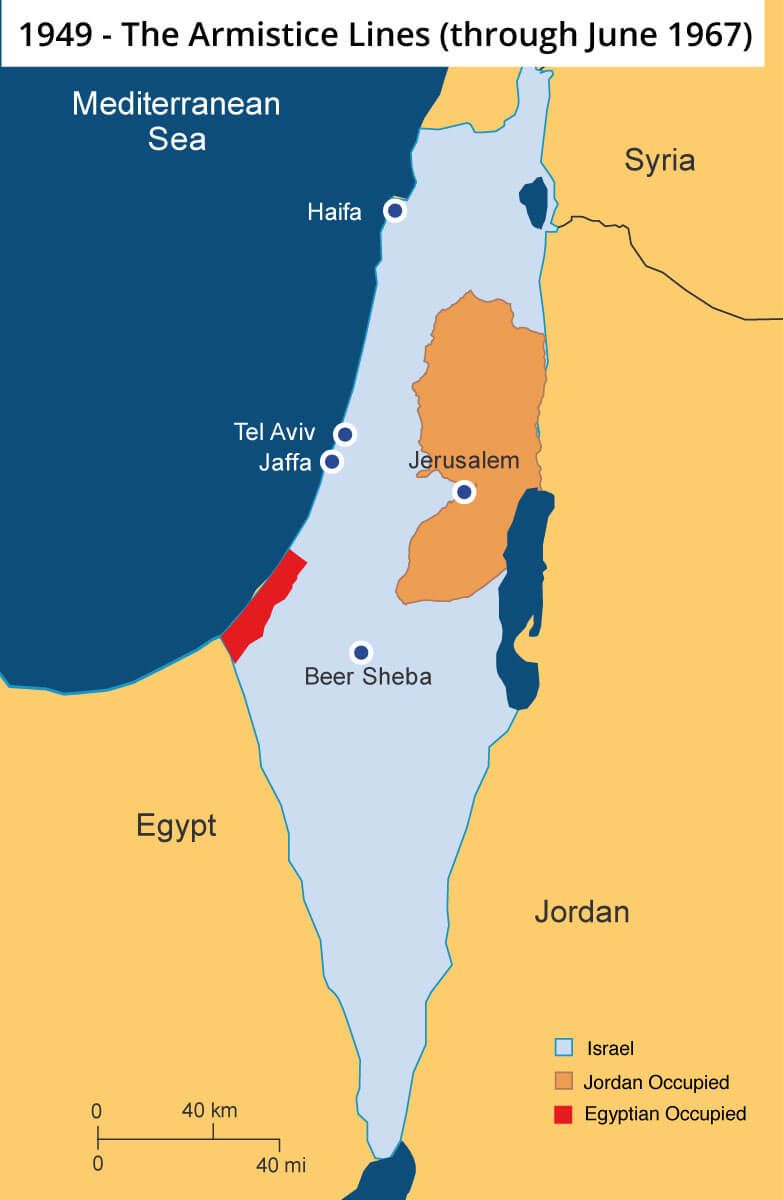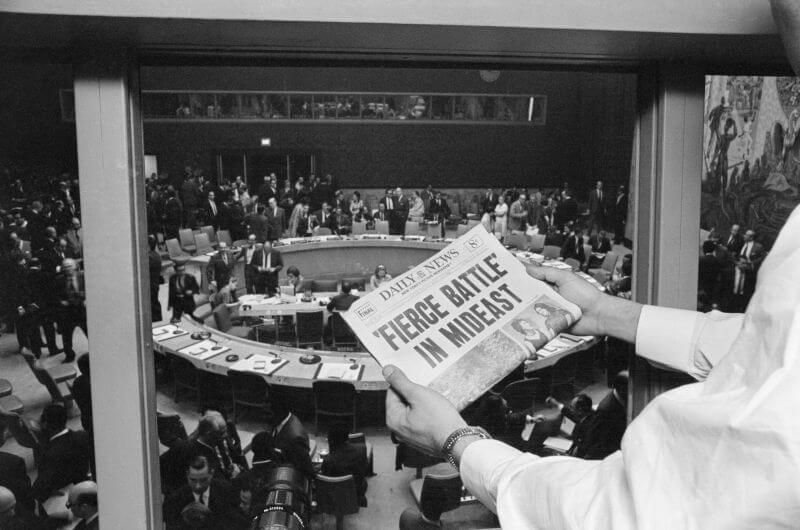Of the thousands of resolutions passed by the United Nations, UN Security Council Resolution 242 is exceptional in that it is one of the few long-standing diplomatic achievements of the world body relating to the Middle East.
More than a half-century after it was unanimously adopted in 1967 in the wake of the Six-Day War, Resolution 242 remains a central pillar of the diplomatic efforts to achieve peace between Israel and its Arab neighbors in the Middle East.
Join the fight for Israel’s fair coverage in the news
What is Resolution 242?
The resolution is a short, succinctly worded agreement reached at the UN following the war in June, 1967 between Israel and its Arab neighbors.
In his treatise on 242, Israeli Ambassador Meir Rosenne called the barely 300 word-long document “the pivotal point of reference in all Arab-Israeli diplomacy since 1967” that appears in every key diplomatic agreement that has been signed.
More than the text itself, major significance lies in the fact that both Israel and most Arab countries at the time accepted the resolution. Its major points include:
- The call for a “just and lasting peace in the Middle East” with implied mutual recognition.
- Israeli withdrawal from “from territories occupied” during the war.
- The right of all states – including Israel – to “secure and recognized boundaries” that includes “guaranteeing the territorial inviolability and political independence of every state.”
- “A just settlement of the refugee problem.”
Related reading: Israel and the UN: How a Good Relationship Turned Toxic
Resolution 242: The Key Semantic Issue
The wording of 242 had major consequences. It contains the origin of the concept in the Arab-Israeli conflict of “land for peace” – Israel withdraws from territory it captured in the 1967 war in exchange for peace and mutual recognition. Before 242, Arab countries as a bloc had refused to recognize Israel.
 The key semantic issue in the text is the wording associated with “withdrawal.” Sir Hugh Foot, Britain’s ambassador to the UN, authored the text of 242, commenting that he specifically wrote “territories” and not “the territories” in order to not force Israel to withdraw to the old armistice lines. Although the French language version of 242 translates as “the territories” and opponents of Israel insisted on a complete withdrawal, Foot was adamant that the English version intended to say only “territories.”
The key semantic issue in the text is the wording associated with “withdrawal.” Sir Hugh Foot, Britain’s ambassador to the UN, authored the text of 242, commenting that he specifically wrote “territories” and not “the territories” in order to not force Israel to withdraw to the old armistice lines. Although the French language version of 242 translates as “the territories” and opponents of Israel insisted on a complete withdrawal, Foot was adamant that the English version intended to say only “territories.”
“It would have been wrong to demand that Israel return to its positions of 4 June 1967 because those positions were undesirable and artificial,” Foot, also known by his title Lord Caradon, said in 1974. “They were just armistice lines. That’s why we didn’t demand that the Israelis return to them and I think we were right not to.”
One major factor missing from 242 is that the words “Palestinians” or “Palestine” are not mentioned at all. The resolution only talks about existing states and calls for a just settlement of “the refugee problem” without referring to UN General Assembly Resolution 194 passed in 1948 that called for returning refugees at the time.
With reference to Resolution 194 apparently left out by design, Israel does not interpret Resolution 242 as containing any notion of a Palestinian “right of return” and therefore sees it as a possible basis for the solution to the refugee problem, the Israeli Reut Institute think tank commented.
Related reading: Israel and the Innate Bias of the UN Security Council
The Historical Context
The tensions and incidents leading up to the Six-Day War were highlighted by repeated calls by Arab leaders for the destruction of Israel, Egypt blockading an international shipping lane and the decision by the UN to cave in to Egyptian demands to remove international peacekeeping troops from the Sinai with a subsequent massive military buildup on the Israeli border.
The existence of Israel is an error which must be rectified. This is our opportunity to wipe out the ignominy which has been with us since 1948. Our goal is clear – to wipe Israel off the map.
– Iraqi president Abdel Rahman Aref, May 31, 1967
With Arab armies massing on its borders and Arab leaders threatening genocide, Israel launched a pre-emptive strike on June 5, 1967. Six days later the war ended with Israel having captured the Golan Heights, the west bank of the Jordan River, the Gaza Strip and the Sinai Peninsula.

With the Arabs having suffered a crushing defeat, the Arab League met in September and issued the the Khartoum Resolution with the infamous “Three Noes” in which the Arab League declared “no peace with Israel, no recognition of Israel, no negotiations with it.”
Yet two months later, UN Security Council Resolution 242 was adopted on November 22 and with it the hope for eventual peace between Israel and the Arabs.
Related reading: Three Noes That Set the Mideast On Course of Conflict
Resolution 242’s Aftermath
The resolution was followed by a UN peace mission lead by Swedish diplomat Gunnar Jarring to try and implement 242. His efforts culminated with a peace proposal presented in 1971, but failure to agree on how to implement it was finally shattered when Egypt and Syria attacked Israel on Yom Kippur in 1973.
The Yom Kippur War was followed by UN Resolution 338 which called for a cease-fire along with both the implementation of 242 “in all of its parts” and peace negotiations between the warring parties. 338 led to the eventual signing of a peace treaty between Israel and Egypt in 1979, followed by a peace treaty with Jordan in 1994.
Israel and Syria, however, remain in a state of war.
In 1988 the PLO accepted Resolution 242 in its declaration of independence. However, at the time the PLO did not explicitly recognize Israel nor call for a peace treaty or a two-state solution, but instead accused Israel of seeking the “extermination of the Palestinian people.” Five years later, Israel and the PLO signed the Oslo Accords.
The Legacy of Resolution 242
Amb. Rosenne noted that while “UN General Assembly resolutions are only recommendations,” Security Council resolutions including 242 are legally binding. The Arab actions leading up to the war were sufficient to determine that Israel was not the aggressor in the Six-Day War. The implication is that with respect to the territories its forces had captured, Resolution 242 assigned Israel legal rights and obligations.

In other words, Israel is obligated to maintain the territories until the warring parties can negotiate to “achieve a peaceful and accepted settlement in accordance with the provisions and principles in this resolution.” That settlement is a required condition for the first principle of 242 – the “withdrawal of Israeli armed forces” – to take place.
The biggest success that has roots in 242 is clearly Israel’s peace treaties with Egypt and Jordan. While the resolution has so far failed to achieve “a just and lasting peace in the Middle East” for all states in the region, peace with two formerly hostile Arab countries bordering Israel drastically changed the nature of the conflict.
More recently, two key Arab dictators who had fomented militaristic anti-Israel sentiment as a tool of their regimes – Iraq’s Saddam Hussein and Libya’s Muamar Qadhafi – were both overthrown. Syrian dictator Bashar Assad rejected his people’s demands for democratic reforms and has presided over a civil war that has crippled his country and removed Syria as a military threat to Israel.
A long-term consequence of 242 is the marked decline in the belligerence of the Arab League of 22 countries that historically served as the collective Arab anti-Israel focus for what was called the Arab-Israeli conflict. That focus has all but disappeared given that two Arab League members have been at peace with Israel for several decades at the same time that other states are in disarray with internal strife. Several members like Morocco and several of the Gulf States do not hide their unofficial ties with Israel. Far from calling for Israel’s destruction, they openly call for cooperation.
What used to be termed the “Arab-Israeli Conflict” has morphed into the “Israeli-Palestinian Conflict.” With the Palestinians apparently irreconcilably split between Fatah and Hamas, any Israeli-Palestinian resolution appears to be unachievable in the short term. Despite those changes, it appears that UN Security Council Resolution 242 will continue to be used as a foundation for future peace.
Liked this article? Follow HonestReporting on Twitter, Facebook, Instagram and TikTok to see even more posts and videos debunking news bias and smears, as well as other content explaining what’s really going on in Israel and the region.


